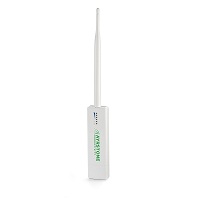 We didn’t invent the idea of putting WiFi on farms and ranches, although I think we’ve done a lot to popularize it. And it’s not really WiFi that’s important, it’s just having a farmwide network that you can connect to and move data with.
We didn’t invent the idea of putting WiFi on farms and ranches, although I think we’ve done a lot to popularize it. And it’s not really WiFi that’s important, it’s just having a farmwide network that you can connect to and move data with.
When we started, we realized there were two ways we could build out the farm wireless network, and that we’d need to support both ways. However, we had to start somewhere, and we knew that the best short-term “proof of concept” was using the mesh network approach: a bunch of high-power WiFi Access Points that are connected to the Internet and talk to each other using a meshing protocol. That’s what gave rise to the AyrMesh Hub.
Because the Hubs can be up to 2.5 miles apart, it allows you to extend your network out quite a ways from your home place, and that’s useful for a lot of people. It also allows you to “get in the game” for a minimal investment – a few hundred bucks for a Hub and a little time putting it up high and out in the clear gets you WiFi across your farmyard and out into your fields. Then you can extend the network from there with additional Hubs.
However, sometimes you just want to connect someplace into your network, and you don’t need to have WiFi. For those cases, a different approach is optimal: point-to-point microwave links, also known as “bridges.”
 A bridge can use WiFi or a WiFi-like signal to connect two locations and pass data between them. Typically they are “Layer 2” devices, meaning that they work just like a long, wireless Ethernet cable. You plug one radio into your network (typically your router) and then plug the other radio into whatever you want to put on your network (a computer, IP camera, WiFi access point, etc.), and everything works just like it was plugged into your router.
A bridge can use WiFi or a WiFi-like signal to connect two locations and pass data between them. Typically they are “Layer 2” devices, meaning that they work just like a long, wireless Ethernet cable. You plug one radio into your network (typically your router) and then plug the other radio into whatever you want to put on your network (a computer, IP camera, WiFi access point, etc.), and everything works just like it was plugged into your router.
The AyrMesh Bridge uses microwave radios that use the 5.8 GHz. band (used for 802.11 WiFi “a,” “dual-band n,” and “ac”), but they use a special “narrow-band” microwave signal that increases the range, reduces the effects of interference, and makes the signal invisible to WiFi “sniffers.”
Of course, if you are just connecting some distant device or devices into your network, you can also use an AyrMesh Hub and an AyrMesh Receiver. It will actually work the same way; the differences are:
- The AyrMesh Bridge is just a wireless Ethernet cable that doesn’t provide a wireless signal usable by anything else. The AyrMesh Hub provides WiFi that other devices can use.
- The AyrMesh Bridge is a “1-to-1” system, but you can have several Receivers talking to one Hub.
- The Receiver can be up to 2 miles from the Hub, but the Bridge radios can be up to 5 miles apart.
It’s not necessarily an “either/or” thing. Several AyrMesh users are using the AyrMesh Bridge to reposition their Gateway Hub to the top of large structures (e.g. grain legs) to give the Hubs maximum range. A couple of people are using their Hubs for WiFi but providing connectivity to other buildings using Bridges (with the Hub and the Bridge radio mounted next to each other on top of the house or office). And you can use a Bridge connected to a Remote Hub to connect a device several miles away from the Hub.
There are a lot of folks out there selling wireless bridges – we think the AyrMesh Bridge is the best for one important reason: it’s the easiest to set up and use. No configuration is needed: you just connect both radios in the Bridge to your router. They download your configuration from AyrMesh.com and then all you have to do is mount them outside pointing at each other.
